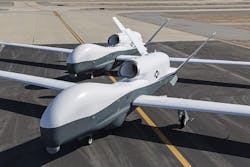Military surveillance strategy for Asia-Pacific region includes Northrop Grumman Triton UAS and Boeing P-8A Poseidon
PALMDALE, Calif., 22 May 2013. Together with the manned Boeing P-8A Poseidon, the Northrop Grumman MQ-4C Triton is expected to be a major part of the military's surveillance strategy for the Asia-Pacific region.
The MQ-4C Triton, having just achieved its first flight, provides the U.S. Navy fleet with a game-changing persistent maritime and littoral ISR data collection and dissemination capability, according to Rear Adm. Mat Winter, who leads the Program Executive Office for Unmanned Aviation and Strike Weapons at Naval Air Systems Command, Patuxent River, Md.
The Triton will fly missions for 24 hours at altitudes greater than 10 miles, allowing the system to monitor 2,000 nautical miles of ocean and littoral areas at a time. The UAS is intended to be a key component of the Navy's Maritime Patrol and Reconnaissance Force.
The P-8A Poseidon is the Navy's new multi-mission maritime aircraft being built to replace the P-3C Orion long-range anti-submarine warfare aircraft.
"When operational, the MQ-4C will complement our manned P-8 because it can fly for long periods, transmit its information in real-time to units in the air and on ground, as well as use less resources than previous surveillance aircraft," explains Rear Adm. Sean Buck, Patrol and Reconnaissance Group commander, witnessed the first flight of the Northrop Grumman Triton UAS. "Triton will bring an unprecedented ISR capability to the warfighter."
The MQ-4C Triton UAS will be based at five locations worldwide. Triton operators will disseminate data in real-time to fleet units to support surface warfare, intelligence operations, strike warfare, and search and rescue missions.
"Our goal is to mature the Triton UAS before supporting the Navy's maritime ISR mission," explains Capt. Jim Hoke, program manager for the Persistent Maritime UAS office (PMA-262), which oversees the Triton program. "The data we collect the next few years is essential to certify the system for operational use."
Flight tests will continue in California for the next several months before the team transitions the aircraft to Patuxent River in the fall.
Follow Avionics Intelligence news updates on Twitter (@Avionics_Intel), LinkedIn, and Google+.
Related stories
Northrop Grumman-built Navy Triton unmanned aircraft achieves historic first flight, begins testing
Military surveillance strategy for Asia-Pacific region includes Northrop Grumman Triton UAS and Boeing P-8A Poseidon
Triton UAV: built by industry leaders, powered by Rolls-Royce engine



